Pooh Bear: Pandas roll in fresh horse manure and rub it over their bodies to help them cope with cold weather
- Experts witnessed pandas rolling in horse excrement 38 times from 2016–2017
- However, the manure is not used by the pandas to create an insulating layer
- Instead, the researchers believe the faeces contain two special chemicals
- They inhibit the panda’s response to cold, helping them cope with the chill
To keep themselves from feeling the cold, giant pandas roll around in fresh horse manure, rubbing it over their bodies, a study has found.
Experts from China witnessed pandas approaching and sniffing manure deposits and before first rubbing the faeces over their cheeks and then smearing it all over.
They found that horse manure contains two chemicals that appear to turn off the cold sensing pathway in pandas, making them better able to put up with the chill.
To keep themselves from feeling the cold, giant pandas roll around in fresh horse manure, rubbing it over their bodies — as pictured — a study has found
‘Attraction to faeces in wild mammalian species is extremely rare,’ the researchers wrote in their paper.
‘Here we introduce the horse manure rolling behaviour of wild giant pandas, Ailuropoda melanoleuca.’
‘Pandas not only frequently sniffed and wallowed in fresh horse manure, but also actively rubbed the faecal matter all over their bodies.’
In their study, biologist Wenliang Zhou of the Chinese Academy of Sciences and colleagues monitored Qinling giant pandas in the wild between 2016–2017 — during which period they witnessed 38 cases of horse manure rolling behaviour.
The researchers noted that the frequency of manure rolling correlated both with the availability of fresh manure, as well as the ambient air temperature — with all recorded cases occurring when the weather was between -5 and 15°C.
As the pandas appear to prefer rolling in faeces that was no more than 10 days old, the team analysed horse manure looking for volatile compounds that might be present in relatively fresh, but not aged, horse excrement.

Experts from China witnessed pandas approaching and sniffing manure deposits and before first rubbing the faeces over their cheeks and then smearing it all over, pictured
Focussing on two such chemicals — ‘beta-caryophyllene’ and ‘caryophyllene oxide’ — the researchers conducted an experiment at Beijing Zoo in which giant pandas were presented with three piles of hay to roll in.
One hay had been treated with beta-caryophyllene and caryophyllene oxide, one with fatty acids and one with water.
The team found that the pandas frequently visited the former pile, rolling it the hay and rubbing such over themselves — while the other two piles were largely ignored.
One panda even spent six whole minutes rolling in the beta-caryophyllene–caryophyllene oxide hay pile.

In their study, biologist Wenliang Zhou of the Chinese Academy of Sciences and colleagues monitored Qinling giant pandas (pictured) in the wild between 2016–2017 — during which period they witnessed 38 cases of horse manure rolling behaviour
Finally, the team conducted experiments with mice, showing that those treated with beta-caryophyllene and caryophyllene oxide were more willing to cross from a warmed plate over to a chilly one, and exhibited fewer cold behaviours like huddling.
The two chemicals, they explained, interact with the thermosensitive receptor pathway of various animals — and, in particular, the so-called TPRM8 pathway of giant pandas — such as to inhibit the activation of the pathway by the cold.
Given this, covering themselves in horse manure containing beta-caryophyllene and caryophyllene oxide may help giant pandas react less to the cold.
The full findings of the study were published in the journal Proceedings of the National Academy of Sciences.

